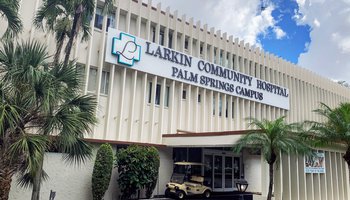
Larkin Hospital Palm Springs
1475 W 49th Pl.. Hialeah, 33012.
Tel: 305-558-2500 | View
Larkin Community Hospital Palm Springs
The Larkin Community Hospital Palm Springs Campus Stroke Program provides evidence-based, American Stroke Association primary stroke care including evaluation, treatment, and education to patients who present to Larkin Community Hospital Palm Springs Campus with signs and symptoms of stroke or transient ischemic attack (TIA). Our Stroke Core Team, including the Medical Director, Stroke Coordinator, and Stroke Committee are actively involved in the stroke program ensuring that all patients receive high- quality, innovative stroke care.
For critical stroke patients who require a higher level of care than Larkin Community Hospital Palm Springs Campus has the ability to provide, partnerships have been put in place to provide transfer to a Comprehensive Stroke Center, with resources to provide comprehensive neurological support and a full range of diagnostic and endovascular therapeutic procedures. These partnerships allow us to share imaging results, such as CT scans, for consultations and collaboration between healthcare provider improving consistencies in stroke care.
Our program also includes the use of medications like TPA, antithrombotics, anticoagulation therapy, DVT prophylaxis, cholesterol reducing drugs and smoking cessation.
To provide optimal, timely, and compassionate patient-centered care to stroke patients; as well as integration to an educational environment for surrounding communities and medical professionals.
Blood flow to the brain is temporarily blocked. Also called a “mini-stroke”, TIA, is a major warning sign of a future stroke.
Blocked blood vessels (blood clots) prevent blood flow to the brain causing hypoxia (low supply of oxygen to the brain) and anoxia (no supply of oxygen to the brain).
Occurs when blood vessels in the brain become blocked or clogged (thrombosis). Blood clots are likely to occur when plaque (fat, cholesterol, lipids, etc.) build up in arteries, disrupting natural blood flow (atherosclerosis).
Occurs when blood clots are carried from another part of the body (often the heart) to the small vessels in the brain.
Often caused by Artrial Fibrillation
Rupture of a blood vessel in the brain (hemorrhage). This causes blood to build up creating pressure on the brain and reduces brain cell function.
Primary Stroke Center | Larkin Health Please Visit or Call The Following Facilities.
Physicians Treating Primary Stroke Center | Larkin Health.